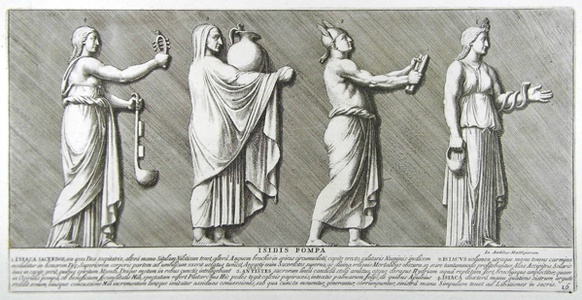| Method | Etching |
| Artist | Pietro Santi Bartoli |
| Published | Domenicus de Rubeis Chalcographus Anno MDCXCIII. Romae ad Templum Sa. Ma. de Pace, cum Privil. Summi Pont. et Licentia Superiorum [1693] |
| Dimensions | Image 185 x 370 mm, Plate 188 x 373 mm, Sheet 363 x 474 mm |
| Notes |
A depiction of a Roman relief panel of Isis worship, Plate 16 from Bartoli's Admiranda Romanarum Antiquitatum (1693). The relief panel, now in the Vatican Museums, was part of the collection of the powerful Mattei family. The scene depicts the pompa (procession) of the devotees of the goddess Isis. Leading the procession is the priestess of Isis, carrying in one hand a Nilotic situla of lustral water. An Egyptian cobra is entwined around her other arm, its hooded head raised. Behind her is a bare-chested priest, his toga rolled down to his midriff. He wears a helmet adorned with two feathers, and carries a scroll before him. Third in line is another priest, wearing a crisp, white toga candida, the folds of which he has used to veil his head and wrap his left hand. Against his chest he carries an urn of lustral water, and his feet are wrapped in linen. The final figure is a priestess who carries the sacred objects of the goddess, the sistrum rattle and a simpulum (ladle) with a handle notched like a Nilometer, the tool that was used to measure the inundation of the Nile. Isis was an Egyptian mother goddess, and closely connected with cults of magic and nature. The consort of Osiris, the god of the dead, her worship and myth cycle also included themes of resurrection and rebirth. By the Roman period, the element of resurrection in Isis' mythology had come to prominence. A temple to Isis was decreed in Rome in the late 1st century BC, though the involvement of Cleopatra in the feud between Antony and Augustus cooled enthusiasm for Egyptian influence in the city. The cult received official imperial backing under Caligula, who instituted the festival of the Navigium Isidis, a procession like the one depicted in this panel. Because of Isis' status as a saviour goddess, her worship was attractive to devotees of many social classes, including slaves. By the second century BC, the cult of Isis had taken on cultic attributes of numerous other deities, including Minerva, Venus, Cybele, Serapis, Mithras, and even Jesus Christ. The principal Temple of Isis and Serapis in Rome gave its name to a regio next to the Caelian Hill. It is likely that the panel depicted in the plate came from that Temple or its immediate surrounds, as the Caelian was the location for the Mattei family's principal Roman palace, the Villa Celimontana. The Admiranda Romanarum Antiquitatum ac Veteris Sculpturae Vestigia Anaglyphico Opere Elaborata ex Marmoreis Exemplaribus was one of a number of illustrated volumes on antiquarian subjects published by the prolific de Rossi family. The work featured 83 etched plates by the antiquarian and engraver, Pietro Santi Bartoli, depicting examples of Roman relief sculpture, all of which Bartoli had viewed and studied in the various papal and aristocratic collections across Rome. Like many of Bartoli's works, the plates of the Admiranda Romanarum Antiquitatum included commentary and notes by the celebrated antiquarian, Giovanni Pietro Bellori, with whom Bartoli enjoyed a long and fruitful academic partnership. The work was dedicated by the publishers to Cardinal Flavio Chigi, nephew of Pope Alexander VII and a member of the powerful Chigi family, who had died in September 1693, the same year as its publication. Cardinal Chigi had been a close friend of Bartoli's patron, Queen Christina of Sweden. His position in such a powerful papal family had also been beneficial to engravers and publishers, particularly those with an interest in classical architecture. Alexander VII had been one of the great 'builder' popes, whose term had endowed Rome with numerous churches, public fountains, gardens, and palazzi in the rococo style, as well as encouraging the excavation, documentation, and in some cases, restoration, of the monuments of the classical era. Many of the relief sculptures depicted in the Admiranda Romanarum Antiquitatum had been rediscovered in these excavations, and were quickly added to the collections of the Chigi family and their peers. Pietro Santi Bartoli (1635 – 7th November 1700) was an Italian draughtsman, architect, antiquarian, and engraver. Born in Perugia, Bartoli apprenticed with Jean Lemaire and Nicholas Poussin. Although he would give up painting following Poussin's death to focus on engraving, the classical scenes that were the speciality of Poussin and Lemaire were probably responsible for the young Bartoli's interest in classical subjects. In collaboration with the antiquarian Bellori and the publishers Giovanni and Domenico de Rossi, Bartoli produced a number of works documenting the art, architecture, history, and culture of ancient Rome. Of particular note are his series of 128 etchings depicting details of the frieze on the Column of Trajan, and a number of plates of Roman monuments after Giacomo Lauro that were published by Domenico de Rossi in his Romanae Magnitudinis Monumenta in 1699. Condition: Encircled fleur-de-lis watermark. Minor time toning to edges of sheet. |
| Framing | unmounted |
| Price | £100.00 |
| Stock ID | 40651 |

